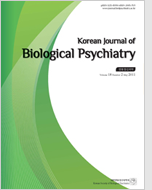
- Past Issues
- e-Submission
-

2021 Impact Factor 1.766
5-Year Impact Factor 1.674
Editorial Office
- +82-01-9989-7744
- kbiolpsychiatry@gmail.com
- https://www.biolpsychiatry.or.kr/

2021 Impact Factor 1.766
5-Year Impact Factor 1.674
Korean Journal of Biological Psychiatry 2015;22(3):101-8. Published online: Mar, 1, 2015
Recent breakthroughs in functional neuroimaging techniques have launched the quest of mapping the connections of the human brain, otherwise known as the human connectome. Imaging connectomics is an umbrella term that refers to the neuroimaging techniques used to generate these maps, which recently has enabled comprehensive brain mapping of network connectivity combined with graph theoretic methods. In this review, we present an overview of the key concepts in functional connectomics. Furthermore, we discuss articles that applied task-based and/or resting-state functional magnetic resonance imaging to examine network deficits in post-traumatic stress disorder (PTSD). These studies have provided important insights regarding the etiology of PTSD, as well as the overall organization of the brain network. Advances in functional connectomics are expected to provide insight into the pathophysiology and the development of biomarkers for diagnosis and treatment of PTSD.
Keywords Post-traumatic stress disorder;Functional neuroimaging;Connectomics.